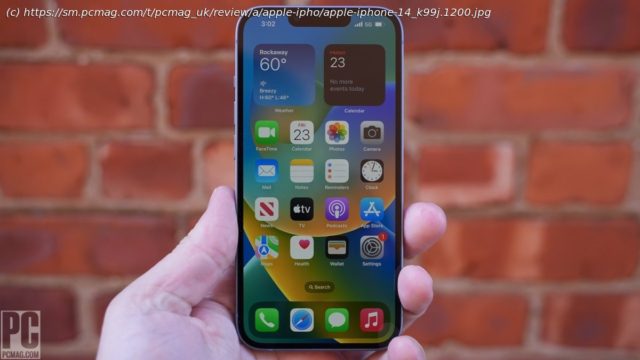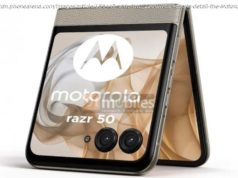The best iPhone for most people isn’t as exciting as it could be
The iPhone 14 is Apple’s meat-and-potatoes smartphone, offering a dependable everyday experience with basics such as an attractive display, excellent build quality, all-day battery life, smooth performance, and competent cameras starting at $799. While it also has some of the pricier iPhone 14 Pro’s features such as Crash Detection and Emergency SOS via satellite, it skips out on the most compelling new experiences offered by that line, including an always-on display, Dynamic Island, and A16 Bionic processor. There’s no question that the iPhone 14 will serve most people well, but it feels a little farther behind Apple’s top-shelf Pro line than previous models have. So while the iPhone 14 Pro Max ($1,099) earns our Editors’ Choice award, the iPhone 14 is still an excellent, safe choice if you’re looking to save some money.Body: Understated Excellence
The iPhone 14 carries over nearly all its external DNA from last year’s iPhone 13, which itself was very much the same as the 2020 iPhone 12. Apple tends to settle on design choices and stick with them for a while (which is why its laptops have looked more or less the same for nearly a decade). While we appreciate that this perhaps helps Apple save on product development costs, it’s hard to convince people to buy a new thing that looks exactly like the old thing. The biggest visual difference between the iPhone 14 and the iPhone 13 is the color palette, which has been updated to Blue, Midnight, Purple, (Product) Red, and Starlight. Notably, the blue and red shades, though bearing the same names, have changed a bit year over year.
The iPhone 14 measures 5.78 by 2.82 by 0.31 inches (HWD) and weighs 6.07 ounces, which is 0.01 inches thicker and 0.07 ounces lighter than the iPhone 13. It’s a supremely comfortable size and weight that should suit most people well. The closest competing phones in terms of quality, cost, and features are the Google Pixel 6 (6.24 by 2.94 by 0.35 inches, 7.3 ounces) and the Samsung Galaxy S22 (5.75 by 2.78 by 0.3 inches, 5.93 ounces). The Pixel 6 is a bit larger than the iPhone 14, while the S22 is a little smaller. If you want more iPhone 14 for not a lot more cash, the $899 iPhone 14 Plus (6.33 by 3.07 by 0.31 inches, 7.16 ounces) might be more your style.
We can’t complain about the high-quality hardware one bit. The iPhone 14 is a glass sandwich design with Apple’s Ceramic Shield protecting the front display and aluminum forming the frame. The pricer Pro range upgrades to stainless steel for the frame but uses the same Ceramic Shield. For comparison, the Pixel 6 and S22 use Corning Gorilla Glass Victus. The iPhone 14 has an IP68 rating for protection from dust and water, meaning it is dustproof and able to sit in six meters of water for up to 30 minutes. If you drop it in mud or a birthday cake, it’s safe to rinse off under a faucet. iFixit says the iPhone 14 is more repairable than most any other iPhone made in the last five years.
The flat-edge design means the iPhone 14 can stand on a flat, level surface without assistance. The right angle formed where the frame and glass meet give the phone a sharp feel that some may people not like. This can be smoothed over with a case. The outer physical controls are the same across all iPhone 14 devices. The dual-purpose power and screen lock button is positioned on the right edge, while the separate volume buttons and a ringer switch are on the left. You can’t ask for higher-quality buttons on a phone. The iPhone 14 family continues to rely on Apple’s proprietary Lightning port, which is located on the bottom edge. It is incompatible with the USB-C port and cables most other phone makers use on their devices. It’s possible Apple will (finally) abandon Lightning with the 2023 iPhone 15, due in part to a USB-C mandate from the EU.
All iPhone 14 models in the US lack a physical SIM tray and instead rely on eSIM (more on this below). iPhone 14s sold outside the US do include a physical SIM tray.
There’s no fingerprint reader, but Apple’s Face ID is the very best when it comes to facial recognition for security purposes. If you want a fingerprint reader you’ll have to opt for the smaller, cheaper iPhone SE ($429). The Same Old Screen
Spec for spec, the iPhone 14’s screen is identical to the iPhone 13’s. The Super Retina XDR OLED measures 6.1 inches across the diagonal and sports 2,532 by 1,170 pixels for a density of 460ppi. It boasts a two-million-to-one contrast ratio and puts out 800 nits of brightness (typical), with a maximum of 1,200 nits (peak).
The refresh rate remains at a static 60Hz, which is a bit disappointing. More phones in the $500 to $800 range have started adopting faster screens at 90Hz, 120Hz, and even 144Hz, including the Motorola Moto G Stylus 5G and Moto Edge as well as the Pixel 6 and S22. Faster screens offer a smoother experience when moving through your phone’s interface (though at the cost of battery life).
From a practical standpoint, the screen it still excellent. It’s sharp, bright, colorful, and looks great no matter what you’re doing with the phone. The iPhone 14 Pro Max has a brighter, faster screen, but you have to hold the phones close to see the difference. Colors on the iPhone 14 might get washed out when used under directly sunlight, but the screen is still visible and usable outdoors.
There is something else, however, that truly sets the iPhone 14 (and 14 Plus) behind the 14 Pro and 14 Pro Max. The iPhone 14 Pro lineup drops the outdated notch at the top of the screen in favor of the Dynamic Island cutout, while also adopting an always-on display (AOD). The Dynamic Island adds an animated experience around the Face ID and TrueDepth camera module with alerts, notifications, and live activities, while the AOD allows you to see the time, date, weather, calendar appointments, and other details without unlocking the phone.Modest Battery Gains
Apple improves battery life a small amount year over year, but not because it uses a bigger battery. In fact, the iPhone 14 has the same 3,227mAh battery capacity as the iPhone 13.






